A stomach-churning trend is taking over social media in Japan, described online as “sushi terrorism”.
Despite hygiene, respect and politeness being of paramount importance in Japan, pranksters have caused havoc for sushi trains across the nation.
Clips of patrons filmed as they deliberately contaminate various utensils, dishes and condiments have gone viral on social media.
In one clip, viewed more than 90 million times on Twitter, a customer licks a communal soy sauce bottle.
In another clip, the same person grabs an unused teacup from a shelf, licks the entire rim, then places it back on the shelf.
If that wasn’t enough to turn your stomach, the patron is also filmed licking his fingers and touching two pieces of sushi on the conveyor belt, before they continue on and are presumably served to other customers.
A separate viral clip shows another customer cleaning his teeth with a toothpick, before placing it back in the toothpick container.
Stockmarket impact
The videos have caused disaster for Japan’s ¥740 billion ($8.1 billion) sushi industry.
Sushiro, the largest sushi restaurant chain in Japan, claims it has suffered reputational and financial damage because of the controversy.
Sushiro’s stock tumbled 5 per cent, amounting to a $181 million loss, Japanese news outlet TV Asahi reported.
The controversy appears to have scared away many customers, with the typically-bustling sushi restaurants now completely empty in videos shared to social media.
Backlash
In light of the backlash, the teacup and soy sauce offender appears to have taken down their Instagram account.
As for the toothpick ‘Russian roulette’ instigator, they’ve changed the name of their account to avoid being tracked down.
The trend has elicited strong reactions, with many declaring they will never go near a sushi train again.
“I will never eat yakisoba or conveyer belt sushi again,” wrote one Japanese Twitter user.
Another remarked that the trouble-makers had “ruined” the experience for others, and others called their actions “inconsiderate and gross”.
“This is not OK. Spreading COVID-19,” remarked one concerned user.
Legal action
Sushiro issued a statement that said the man responsible for the soy sauce and teacup videos has apologised, as had his parents.
It said, however, that it still planned to pursue legal action.
Sushiro is now taking extra sanitary precautions, Japanese media reports.
All of the chain’s soy sauce bottles were replaced, and all of its teacups were washed.
Condiments and utensils are no longer available on restaurants’ tables, with customers required to collect them from designated pick-up points.
Some Japanese social media users reported that their local sushi trains had temporarily stopped serving food on the conveyer belts – with only table service available for now.
Two other sushi chains, Hama-Sushi and Kura Sushi, informed Jiji Press agency they also plan to take legal action.
They also confirmed their plans to install cameras above sushi conveyer belts to monitor customers.
Up to no good
Although this “sushi terrorism” trend may be shocking, it’s actually nothing new in Japanese culture.
The viral videos appear to be in the same style of an existing Japanese YouTube trend, known as “meiwaku-douga”, or “nuisance videos”.
And while this specific incident has set off a chain reaction, pranksters have been filming such stunts in Japanese sushi train restaurants for years.
Years ago, restaurants were forced to step in amid a wave of so-called “wasabi terrorism”.
During this phase, many patrons were filming themselves dolloping heaps of wasabi onto plates on the conveyer belt, only to be consumed by an unsuspecting customer.
And bad behaviour has been rampant at these establishments for years.
Resurfaced clips show diners grabbing nigiri off plates with their used chopsticks, instead of taking the entire plate as intended.
As of now, it doesn’t appear that this bad behaviour has spread to sushi restaurants in Australia.
Source: the new daily































